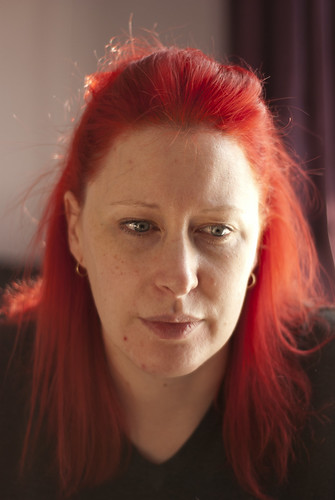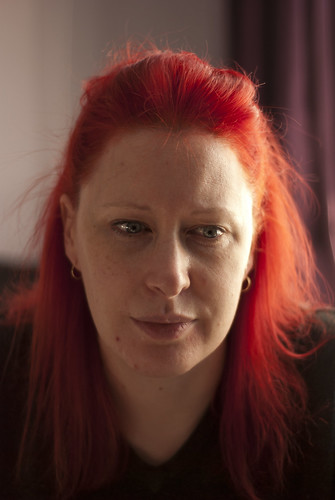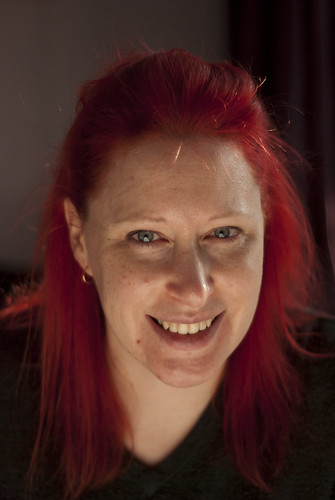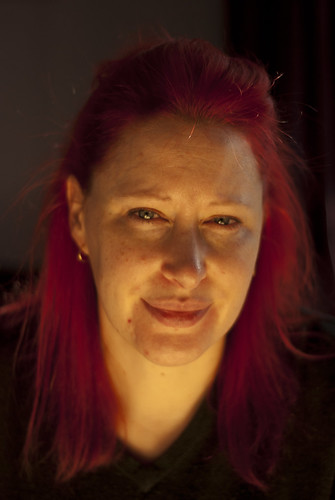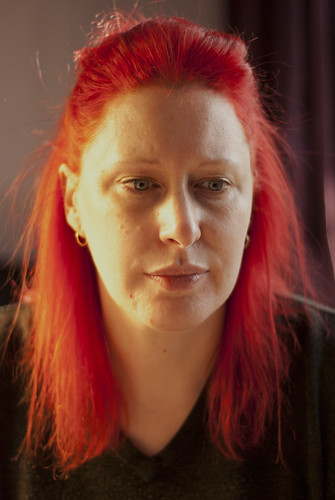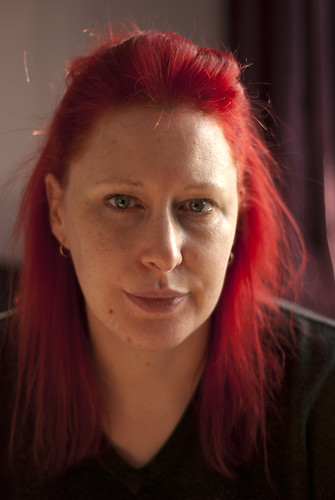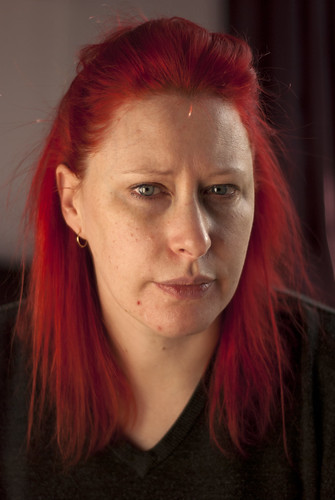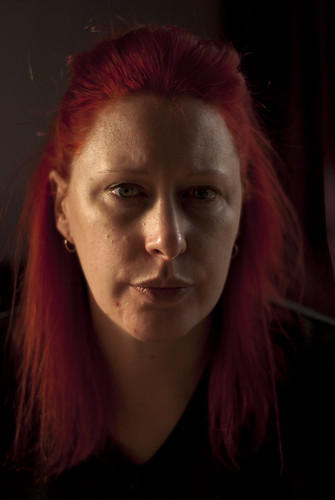What: The main brief of this exercise was to have a look at the environment and see if I could locate and photograph some places which could be used as a background for a image. I had to then pick on and return and take a portrait,
Where: In and around Edinburgh
When: During the day, in overcast weather and in light rain.
How: I went looking for backgrounds so that I could examine them and see if I could to identify a way in which I could photograph a person against this environment without the background becoming the focal point of the image.
I took a trip into Edinburgh and looked around a small part of the Meadows area which has been redeveloped. The first location I came across was next to a hotel and I noticed the vertical brown branches against the grey horizontal slabs of the wall. After photographing the location, I sat and thought about what was in front of me and while this is an interesting background, if not used correctly it will create a grid against which the person will stand and this will cause the eye to be drawn away from the subject and into the grid.
Nikon D80, focal length 50.0mm (35mm equivalent 75mm), aperture f1.7, speed 1/30 second, ISO 400, Flash white balance, matrix metering, hand held camera, 50mm lens, No flash.

The next location I scouted was a wall which showed the various different colours of sliding used across the Quartermile site; the grey interlocking cladding was part of the architects (Robert Smith) design and I feel that it looks like the different colour of roof slate available to roofers for the last two hundred years. I like the interlocking shape and colours and to use it at as a background I will have to ensure that the subject wears bright colours to contrast against the greys and blacks.
Nikon D80, focal length 50.0mm (35mm equivalent 75mm), aperture f2.4, speed 1/125 second, ISO 400, Flash white balance, matrix metering, hand held camera, 50mm lens, No flash

The third location I wanted to examine was one used by the early photographers D.O.Hill and R. Adamson, they took a number of calotypes in the Greyfriers graveyard and after seeing a number of the images I wanted to track down the location of one of the images and see if it was still suitable for a background. The Dennystoun monument has changed a bit since they took their photograph and it does not have the same impact now as it did then, however I believe that using monochrome would produce a good image as although there is not a large variation in colour there is quite a variation in texture. If the image was to be taken in colour then the background would overcome the final image as there is a lot of grey there and it would take a striking slash of strong colour to draw the eye away.
Nikon D80, focal length 34.0mm (35mm equivalent 51mm), aperture f4.2, speed 1/125 second, ISO 400, Flash white balance, matrix metering, hand held camera, 18-70mm lens, No flash.
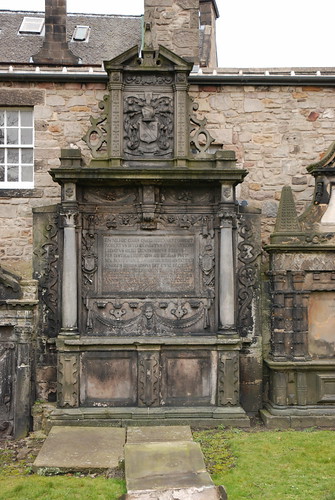
The fourth location I examined was also in the Greyfriers graveyard, over in the far left corner of the graveyard is the covenanters prison, an area of the graveyard which was used as an open air prison for covenanters and their families. This part of the graveyard remains locked and is only opened on special occasions. I looked through the bars thought that a view to the bars and slightly beyond may be a good background. However on examining the images, I felt that the more modern buildings in the upper half of the frame broke the idea and drew the eye away from the foreground which is just the bars and the lock.
I went across the road from Greyfriers and into the Scottish museum to scout out a few upper story and inside locations, I had made up my mind before arriving at the location that I wanted to use the uppermost floor and get a view down the length of the Victorian main hall. I wanted to get the pillars and roof brackets as a repeating feature in the background and have the subject off centre in the foreground. It depends on the day of shooting as the amount of light coming through the roof needs to be balanced with the tungsten lighting inside the building as otherwise there may be a conflict in white balance and this may throw the final image off colour.
Nikon D80, focal length 18mm (35mm equivalent 27mm), aperture f8, speed 1/45 second, ISO 400, Cloud white balance, matrix metering, hand held camera, 18-70mm lens, No flash
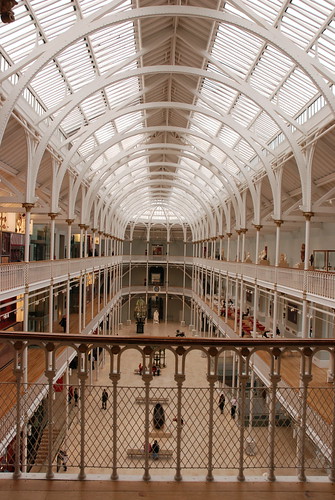 Nikon D80, focal length 18mm (35mm equivalent 27mm), aperture f8, speed 1/45 second, ISO 400, Cloud white balance, matrix metering, hand held camera, 18-70mm lens, No flash
Nikon D80, focal length 18mm (35mm equivalent 27mm), aperture f8, speed 1/45 second, ISO 400, Cloud white balance, matrix metering, hand held camera, 18-70mm lens, No flash

I then went up to the roof of the museum and looked at using the city as a background, but as this is a portrait of a person rather than the person in a certain location, the cityscape is too powerful and draws the eye away. It would probably be better suited for a travel style portrait rather than a plain portrait against a simpler background.
Nikon D80, focal length 50.0mm (35mm equivalent 75mm), aperture f22, speed 1/20 second, ISO 400, Cloud white balance, matrix metering, hand held camera, 50mm lens, No flash.

I continued inside the museum looking for something which would make a visually stimulating but not over powerful background. I took a few shots of the lens of a lighthouse as a consideration. The lens itself is a good source of light and with a plain white reflector I feel that I can get quite a bit of light onto the face of the subject without over or underexposing the image. I do have a concern that the lens structure itself may be overcomplicated and a draw away from the eye, but I am sure that if i compose correctly that it may make a very good background.
Nikon D80, focal length 50mm (35mm equivalent 75mm), aperture f8, speed 1/20 second, ISO 400, Cloud white balance, matrix metering, hand held camera, 50mm lens, No flash
 Nikon D80, focal length 50mm (35mm equivalent 75mm), aperture f1.8, speed 1/45 second, ISO 400, Cloud white balance, matrix metering, hand held camera, 50mm lens, No flash.
Nikon D80, focal length 50mm (35mm equivalent 75mm), aperture f1.8, speed 1/45 second, ISO 400, Cloud white balance, matrix metering, hand held camera, 50mm lens, No flash.
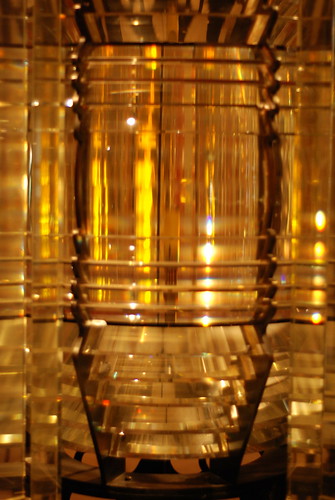
Outside of the museum at the back of a theatre there is a long stretch of hording which has been left for people to create graffiti art on. I liked a couple of the areas and stopped to photograph them; I liked the clean lines and the bright yellows, blues and pinks I think that they would all make very good backgrounds as they are colourful but not too powerful and distracting. I found a particular good graffiti of a skull I liked but I felt that the extra graffiti over the top of it detracted from the image and I did not want to use a background which was full of swearwords and unsuitable language, mainly as I feel it would drew the eye away as people examined the image and then tried to work out what the lettering was saying.
Nikon D80, focal length 50mm (35mm equivalent 75mm), aperture f1.8, speed 1/1500 second, ISO 250, Cloud white balance, Spot metering, hand held camera, 50mm lens, No flash.
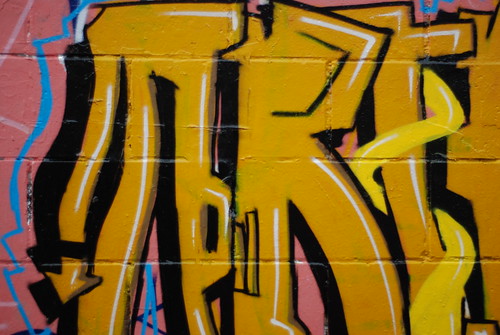 Nikon D80, focal length 50mm (35mm equivalent 75mm), aperture f1.8, speed 1/3000 second, ISO 250, Cloud white balance, Spot metering, hand held camera, 50mm lens, No flash
Nikon D80, focal length 50mm (35mm equivalent 75mm), aperture f1.8, speed 1/3000 second, ISO 250, Cloud white balance, Spot metering, hand held camera, 50mm lens, No flash

The last location I looked over that day was at the meadows, I thought about using a line of trees with the idea of using a person in the foreground leaning against the foremost tree; however I did not like a final pattern and it looked very dull and lifeless.
Nikon D80, focal length 50mm (35mm equivalent 75mm), aperture f9.5, speed 1/60 second, ISO 250, Cloud white balance, Spot metering, hand held camera, 50mm lens, No flash
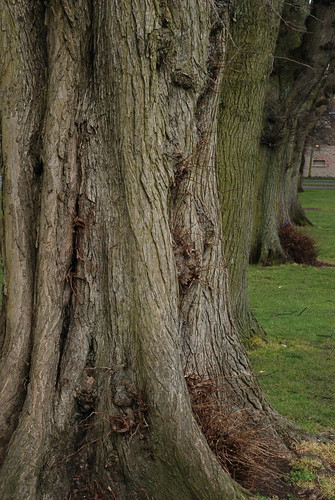
After reviewing the images at home, I mulled over a number of ideas discarding some of the locations quickly while some were harder to decide on. In the end, it was while looking at a print in a magazine I hit on a similar idea to the one they had portrayed. In the image in the magazine the model was standing in front of some industrial steel doors, the doors themselves were a very blue grey and they had the model in a bright coloured dress. With this in mind, I decided I wanted to have my model in black and orange against the multi tonal grey background.
After a few weeks of going back and forth to hospitals and appointments, I finally returned to the location of the grey interlocking cladding and having the model stand in a few feet in front of the wall, I used a 50mm prime lens at f/9 and f/1.8 to photograph her first in portrait orientation and then in landscape. I discared the f9 aperture images as the wall was too well defined and although it was a neutral colour it was very distracting.
I was instantly happy with the other results using f1.8, reviewing them on the camera with her as we could see that her hair and t-shirt provided the colour tonality that I wanted. I was also surprised to find that I had positioned her in a location that the aperture of the camera even at f/1.8 did not blur the background too much.
In the end I decided to post three of the best images here;
Nikon D80, focal length 50mm (35mm equivalent 75mm), aperture f1.8, speed 1/750 second, ISO 250, Cloud white balance, Spot metering, hand held camera, 50mm lens, No flash
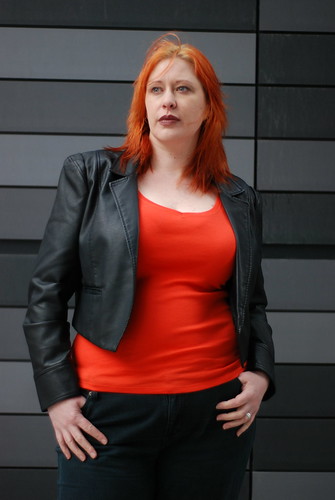 Nikon D80, focal length 50mm (35mm equivalent 75mm), aperture f1.8, speed 1/750 second, ISO 250, Cloud white balance, Spot metering, hand held camera, 50mm lens, No flash
Nikon D80, focal length 50mm (35mm equivalent 75mm), aperture f1.8, speed 1/750 second, ISO 250, Cloud white balance, Spot metering, hand held camera, 50mm lens, No flash
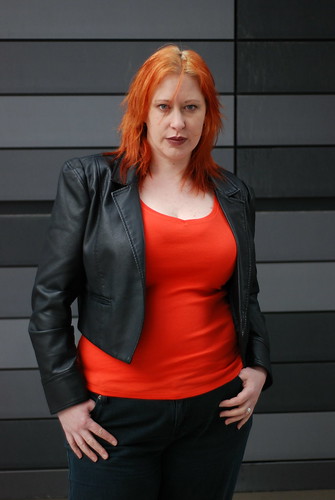 Nikon D80, focal length 50mm (35mm equivalent 75mm), aperture f1.8, speed 1/750 second, ISO 250, Cloud white balance, Spot metering, hand held camera, 50mm lens, No flash
Nikon D80, focal length 50mm (35mm equivalent 75mm), aperture f1.8, speed 1/750 second, ISO 250, Cloud white balance, Spot metering, hand held camera, 50mm lens, No flash
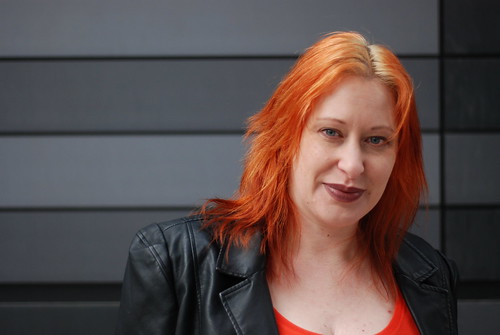
I found that in a lot of cases there was a lot of mess to be tied away or time spent waiting for the area to be clear before photographing, as well as finding a lot of locations were not consistent in tone, light or features. I think is some cases a background with strong clashing colours could work well with the subject matter and would help enforce the overall idea, in other cases it can be too distracting. Overall in this exercise I think that I have learned that plain consistent backgrounds are not always the best idea and that I should keep my eye out for locations which can be used at a later date or ones that fit a certain brief.
It has also helped me to ensure that my notes are detailed and clear and that I can find a location a second time if I want to revisit or use it.
